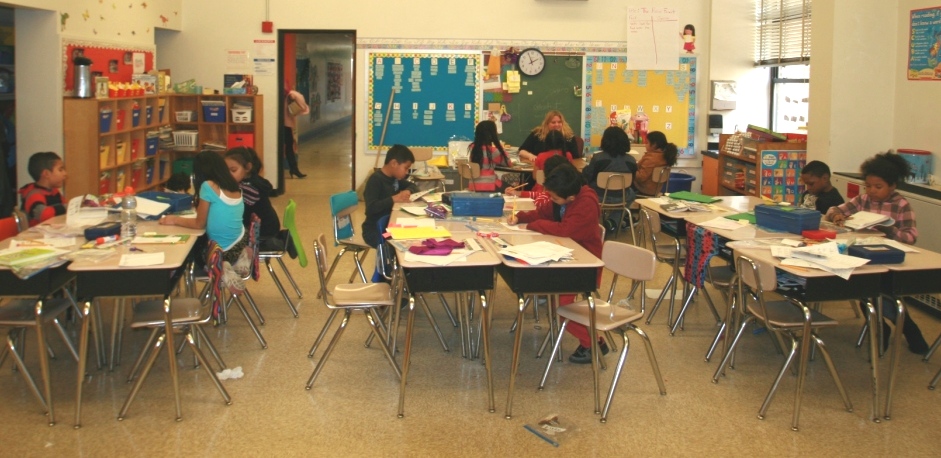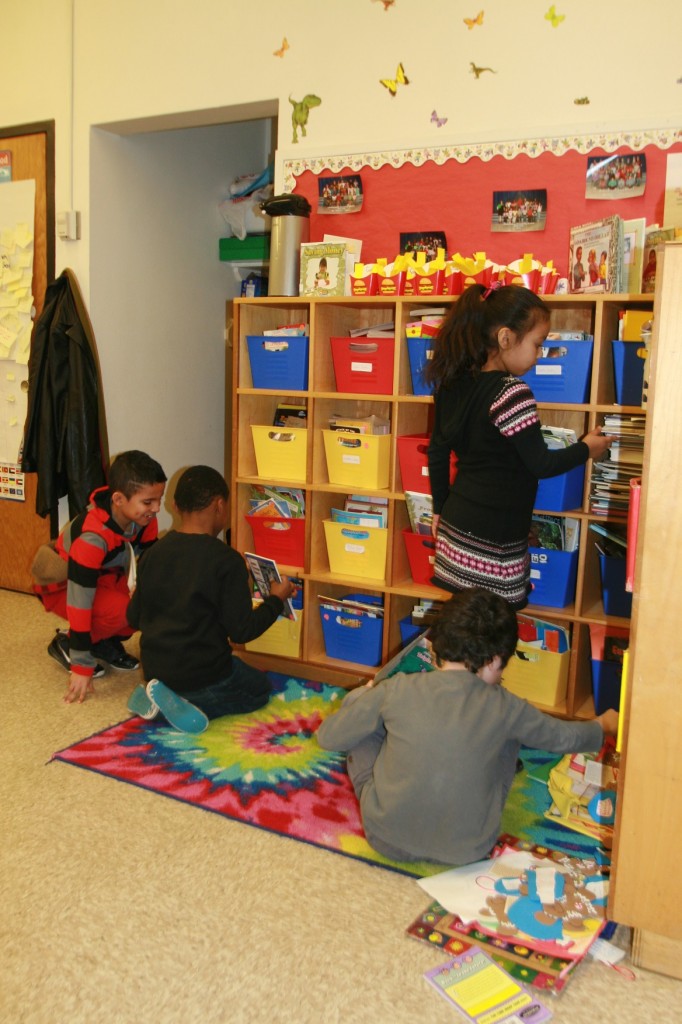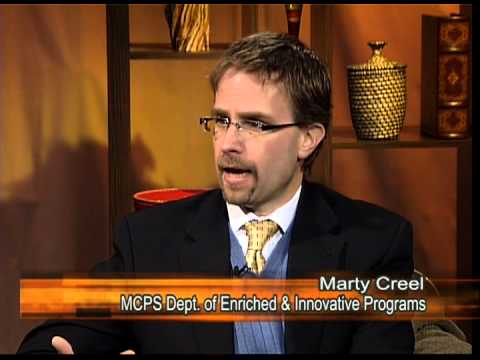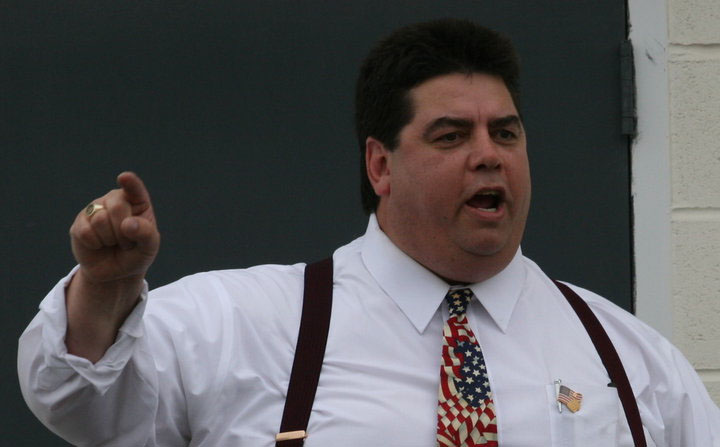Common Core curriculum in practice is embraced and vilified

A second grade classroom at Gaithersburg Elementary School. (Photos by Glynis Kazanjian, MarylandReporter.com)
By Glynis Kazanjian

Second grade teacher Ashley Thornton conducts a small group reading session with Kristina, Cindy, Romeo and Valeria at Gaithersburg Elementary School.
On a snowy afternoon at Gaithersburg Elementary School, second grade teacher Ashley Thornton huddled with two students in her classroom. It was time for their small group reading session.
Thornton was ready to delve into deep discussion about word meaning, risk-taking and a social studies element or two — combining a number of subject areas in one instructional session.
“We are trying to build a deeper understanding,” said Margaret Sybert, a Montgomery County Public Schools staff development teacher based in Rockville. “Kids are talking to each other about what they’re learning.”
All are features of the Common Core State Standards, a new set of curriculum goals introduced into Maryland’s public schools that has left some people happy and some people mad.
Then and now
That particular day, Jose and Aaliyah would be learning about comparing “then and now,” a Common Core social studies concept used in the curriculum. Thornton used a “Venn diagram” (a diagram that shows logical relations between a finite collection of sets) to illustrate how technology affects the way people live, work and play.

Second grade teacher Ashley Thornton conducts a small group reading session, teaching Common Core standards, with Aaliyah and Jose at Gaithersburg Elementary School.
Thornton asked the children to open a book about calendars. While the small group session met for 20 minutes, the remaining children used the time to read, work on opinion writing or play an educational game.
As Aaliyah read a passage from “Seven Days A Week,” she misread a word.
“Long ago people used rocks,” she said. Aaliyah was looking at a picture of a Mexican stone calendar, when she said “rocks” instead of “calendar.”
Part of the Common Core standards have teachers show the students how to use images to aid in reading text.
Thornton praised Aaliyah for looking at the picture, but then asked her to “frame” the word, in addition.
“Does the beginning of the word have an “rrr” sound?” Thornton asked. “No,” Aaliyah shook her head.
Thornton asked if the beginning of the word started with a different letter. ”Yes, it has the word ‘C’ at the beginning,” Aliyah said.
Thornton corrected Aaliyah and asked, “What do letters make when we put them together?”
“Words,” Aaliyah said.

Students select books to read during independent reading time in Ms. Thornton’s second grade classroom at Gaithersburg Elementary School.
Thornton explained that rather than using a standard text that all the children would read from, Common Core offers educators the flexibility to pick individualized selections so that teachers can match books to the needs of different students.
At the end of the first session, Thornton asked each student to give an example of a comparison, and that concluded their guided reading session, which now includes elements of Common Core’s English Language Arts Standards.
“We have always done small reading groups, but now it’s standards-based,” Thornton said, who has been at Gaithersburg Elementary for eight years. “We are hitting it with four or five different angles.”
Thick questions and thin
Next up were Kristina, Cindy, Romeo and Valeria. Thornton asked the children to identify a question they had been given the day before as “thick or thin.”
A Common Core objective is to get students to understand key details in text by defining who, what, where, when, why and how.
A thick question is one that must be thought through and considered. A thin question only needs a basic, straightforward answer, Thornton said.
The students expressed reservation about answering the question, so Thornton asked them to take an “intellectual risk,” a feature of Montgomery County’s curriculum developed around the Common Core standards. The skill is designed to provoke critical and creative thinking.
Next, the children then got out their “Secret Agent Field Mouse” books. Thornton discussed the mouse traps and dilemmas one of the characters encountered.
“Is this a character challenge?” Thornton asked. The exercise is designed to analyze how characters in a story respond to major events and challenges.
Another book came out, “Ocean Life.” Thornton asked if the text was “informational” or “fictional.” Students are taught to identify various text features — such as captions, bold print, subheadings, glossaries and indexes — to help determine whether a text is fact or fiction.
Context and content
“In Common Core, we use vocabulary in context and content-skills to get to the meaning of the word,” Thornton later explained in an interview.
During a break between reading groups, a student approached Thornton with a book from the classroom library.
“Is this a boy or a girl?” the student asked of the picture on the book cover.
“The title says Susan,” Thornton responded, pointing to the name on the cover. “Let’s use our context to answer that question.”
The boy smiled. He knew the answer.
Implementing Common Core
 And thus begins the journey in schools across Maryland and, along with it, the controversy that comes with Common Core.
And thus begins the journey in schools across Maryland and, along with it, the controversy that comes with Common Core.
Maryland formally adopted the Common Core state standards in 2010. Common Core was included in Maryland’s application to compete for federal funding in President Obama’s Race to the Top education initiative.
The state got a four-year, $250 million federal grant and was required to have Common Core fully implemented by this school year, renamed as Maryland’s College and Career-Ready Standards.
Race to the Top also required the creation of a statewide student data system that will monitor student progress through high school graduation. It also demanded a more focused teacher evaluation system based partly on student performance.
Both measures have proven controversial. Parents, teachers, educators and lawmakers are trying to fight the new reforms through legislative efforts this session.
The standards are designed to to have students ready for college or work by their high school graduation.
But the implementation process has been slow and plagued with complaints and criticisms from teachers, parents and lawmakers. One of the chief complaints from parents is that they never had a say in deciding on the new curriculum.
Parents say they had no say

Kathy Butler, a Baltimore County parent, protests at the Parental Awareness of Common Core rally in Annapolis.
“Parents didn’t find out about the reforms until they were implemented,” said Ann Miller at an anti-Common Core rally at the State House in late January. Miller started two Facebook groups opposing the new standards. Combined, they have more than 6,500 followers.
“I would like to be able to vote on our children’s education policy,” Baltimore County parent Kathy Butler said at the rally.
“There has been no citizen input,” said Kimberlee Shaw, an Anne Arundel county parent.
While State Board of Education spokesman William Reinhard said the state has complete jurisdiction over determining educational curriculum, he rejected the notion that parents were not informed.
“It was not under the radar at all,” Reinhard said. “[However], curriculum matters in Maryland under the Constitution sit with the State Board of Education. The State Board discussed it in open session and national discussions on the standards had been taking place for more than a year at that point.”
Some parents say their children are being left behind, while others say Common Core standards are limited to the basics, calling it a “one-size-fits-all” curriculum. Others say it moves away from traditional education teachings.
“There doesn’t seem to be a remedy at the local level for parents, teachers, administrators or anyone who has concerns with certain aspects of the new standards, specifically developmental concerns in the younger grades,” said Julie Jones, a Howard County mother with two children in public school.
Core curriculum called inflexible
Morna McDermott, a 25-year veteran educator with two children in Baltimore County public schools, said the standards limit a teacher’s ability to deviate from what is being taught. McDermott is also co-founder of United Opt Out, a national organization dedicated to eliminating testing accountability in public education by encouraging a national opt out movement.
“It reduces, if not outright eliminates, the child’s teachers’ flexibility to teach to the children,” McDermott said. “It is copyrighted, and while things can be added they cannot be taken away.”
But Marty Creel, Montgomery County Public Schools director of curriculum and instruction, said he doesn’t understand the focus on copyright as an issue.
“Almost all instructional materials, textbooks, articles, films, etc. are copyrighted, but this in no way compels their use,” Creel said.
“The Common Core State Standards are a set of standards, or list of what students should know and be able to do, by grade level,” he said. “To help students reach those standards, schools and teachers have to think of many different ways, using a wide variety of resources and techniques, to help students get there – this requires enormous creativity.”
Creel also said as far as American history goes, the foundation of Maryland social studies standards has not changed.
Creel said that while Common Core has introduced the use of non-fiction books and informational texts, the standards don’t dictate what is read, but the state and school districts do provide a list of recommended readings.
“School districts and teachers decide what books are read,” Creel said.
Biggest challenge is math curriculum
Creel acknowledged that the biggest challenge in Common Core is the change in the math curriculum.
“Some of the math is taught earlier and some is taught later,” Creel said, when comparing the old standards to the new. “It’s a mixed bag.”
The math standards are set up to teach fewer topics each year, but with the goal of giving students a deeper understanding of each component before they move on to the next level.
Students are also being asked to apply their answers to real world situations.
“Students are asked to describe a situation where they would use the math application in a real world setting,” Creel said.
Thornton said that most of the pushback she hears from parents is related to math.
“There is a lot of fear around change,” Thornton said. “We teach 12 different strategies, instead of just one way. Students are also allowed to pick what strategy works best for them.”
Sybert, of Montgomery County Public Schools, said she has noticed parents having trouble helping their children do homework.
“[It is] much more scripted and much more structured,” Sybert said. “Parents may be having trouble supporting their children in math because it is so different from the way they learned it.”
Math standards criticized; other standards untested
Opponents say, the new math standards slow down learning.
“Dr. James Milgram, professor of mathematics at Stanford University, served as the only mathematician on the Common Core validation committee,” said Del. Mike Smigiel, R-Cecil, who is sponsoring legislation to repeal Common Core. “Milgram said the math standards would put students two years behind those of many high achieving countries. He refused to sign off on the math standards.”
Smigiel also pointed out that Sandra Stotsky — the only English Language standards expert on the Common Core validation committee — refused to sign off on the standards. Stotsky is known nationally for her opposition to the Common Core.
Smigiel contends that the Common Core standards are untested.
“The standards themselves have been tried nowhere in the world,” Smigiel said. “So if Maryland is No. 1 in the nation, why would we go and pick up something that has never been tried anywhere?”
Creel, Thornton and Sybert argue, though, that one of the key advantages of Common Core is that the same standards are being taught the same way across the country.
“Now we take topics and ideas and instead of saying you need to know 3,000 different things, we’ve narrowed it down to a few benchmark ideas that are required,” Thornton said.
Everyone on the same page
 “Everyone’s more on the same page in what we are teaching,” Sybert said. “What is being taught in second grade in Maryland is being taught the same in North Carolina.”
“Everyone’s more on the same page in what we are teaching,” Sybert said. “What is being taught in second grade in Maryland is being taught the same in North Carolina.”
Creel said the standards are more thought-oriented and have a bigger emphasis on evidence. There is also a strong emphasis on writing.
Common Core requires more specifics and teaches writing from the beginning stages: brainstorming, outline, feedback, drafts, etc. “The writing program builds across the grade levels,” Creel said.
“These are 21st century skills,” Creel said. ”This is a big shift for us, especially at the elementary level.”
Currently, there are at least a dozen bills moving through the state legislature attempting to tweak, slow down or stop Common Core.
In response to criticisms, Creel said the idea that Common Core is replacing an entire education system is off base.
“Anything new is more work,” Creel said. “In most cases, what Common Core represents is not a total replacement, but an upgrade. This idea that you’re kind of getting rid of everything we used to do is a misunderstanding. It’s really the next step in the evolution of teaching.”

MarylandReporter.com is a daily news website produced by journalists committed to making state government as open, transparent, accountable and responsive as possible – in deed, not just in promise. We believe the people who pay for this government are entitled to have their money spent in an efficient and effective way, and that they are entitled to keep as much of their hard-earned dollars as they possibly can.



